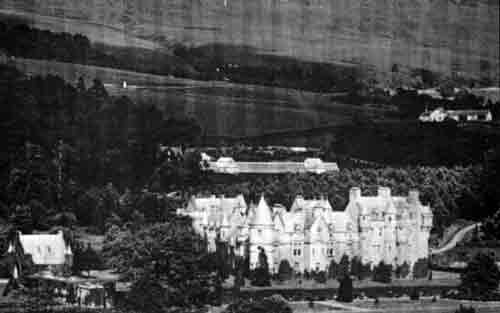
THE BUILDING OF THE CASTLE.
The date of this is unknown. Sir Archibald Edmonstone, 3rd Bt., in his history of the family (privately printed in Edinburgh in 1875) states that "it was one of the fortalices of the Lennox, to which additions were subsequently made."
Duntreath is mentioned in the mid- 13th century, and a charter of 1408 records the resignation of the lands of Duntreath by Donald Earl of Lennox to his brother Murdoch de Levenox.
The building of the square tower, now no longer inhabited, is attributed to Sir William, Ist of Duntreath. The R.C.A.H.M.S. (Vol I Stirlingshire. P258) states that part of an earlier building, probably built soon after 1364, forms the SE gable wall of the 15th century tower to the height of two storeys. The line of its quoins are visible on the longitudinal walls. (The first floor of this earlier building, reconstructed probably as a chapel, later became the dining room during Victorian times.)
Sir William Edmonstone probably built the tower about 1452. The structure is characteristic of the latter half of the 15th century. Consisting of three floors and an attic, the walls of yellow sandstone (on average four feet thick) are topped by a parapet walk of a later date. Within the tower is divided by a central cross-wall with a staircase on each side.
The low arched doorway formally opened into the courtyard. From behind it the main turnpike stair, easy to defend with a sword, runs up to the height of the roof. A passage from the foot of the stair leads to a vaulted room, on the west side of the tower, which is thought to have been the original kitchen and dining hall. The R.C.A.H.M.S.(p257) states, "recesses, which have the appearance of joist holes, suggest that originally an entresol floor of timber was constructed...further evidence for its existence is to be found in the design of the small turnpike-stair in the N angle, the threshold of which is situated 5ft. above the present floor-level and is thus suitably placed to be ...a loft floor. A range of cellars, with iron barred doors, on the S side of the kitchen, traditionally used as dungeons, have now been converted into a garage.
The first floor seems to have been divided between a hall and a solar. The second floor contained the armoury and what appears to have been the master bedroom. George IV is said to have slept here during his visit to Scotland in 1822. The attic floor above was converted during Victorian times into housemaids' bedrooms.
The date of the completion of the courtyard is unknown, but the castle is believed to have surrounded a central quadrangle (a refuge for people and animals in emergency) at least by the 16th century.
.......
Following the near extinction of her family in 1425, the Duchess of Albany, daughter and heiress of the Earl of Lennox. had taken refuge in a fastness of the island of Inchmurrin in Loch Lomond.
James, her only surviving son, had fled to Ireland taking with him the widow and children of his brother Walter. Walter's sons Andrew, Arthur and Walter, had letters of legitimisation under the Great Seal on 17th April 1479. Andrew, under the designation of Andrew Stewart of Albany, was a member of James II's council in 1440, and later, created Lord Avondale, became Chancellor of Scotland.
After the death of James I, in 1437, the Duchess of Albany regained her inheritance. Her granddaughter Matilda, described by Sir Archibald Edmonstone, 3rd Bt., as "the only daughter of her surviving son James" married William, 2nd of Duntreath, son of Sir William Edmonstone and his wife the Princess Mary.

Duntreath Castle, circa 1930
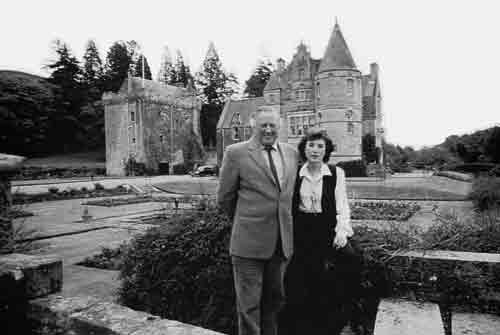
Duntreath Castle 1995, Sir Archibald and Lady Edmonstone in front of their ancestral home.
(Photographed courtesy of the Oban Times Ltd.)
…….
Sir Archibald however, in this instance, seems to have been wrong, having been misled by the historian George Crawford, with whom the error originated. Research in the Scottish Record Office has shown that Matilda was in fact the daughter of Walter Stewart, the second son of Duke Murdoch of Albany, who, together with him, was executed by James I of Scotland in 1425.
Circa 1445, probably on her grand-daughter's marriage, the Duchess granted the lands of Duntreath to William Edmonstone, with the proviso that his father retained a life rent. In the charter of Duntreath by Isabella, described under her own title of Duchess-Countess of Lennox, to Sir William Edmonstone and Matilda Stewart his wife, the substitutes are Andrew, Allan and Murdoch Stewart, who were, almost certainly, Matilda's brothers.
The marriage of Sir William to Matilda is attested by a precept of sasine, among the family archives, of the lands of Dumgoyak, (the conical wooded hill to the south west of the castle) and other portions of Duntreath, dated May 17, 1456.
Additional confirmation of ownership came when Matilda's brother Lord Avondale, acquired both the life rent of the earldom of Lennox and the guarantee of the lands of Duntreath to his brother-in-law, Sir William Edmonstone.
The family historian Sir Archibald Edmonstone, 3rd Bt. was shown a deed from the charter chest of the Duke of Montrose, dated 24th June 1477, which referred to a charter of James III. It concerned the resignation of lands of the Lennox, previously held by his family, to the Chancellor Lord Avondale by John Lord Dernlie (Darnley) on the stipulation that "our cousing Wilyeam Edmonstoun of Duntreath be made sicker (sure)...of the lands of Duntreth, Dungroyabir, the Quhilt, Ballewane, Blairgaro (Blairgar) Enbaly (Edinbelly near Balfron?), the Glyn and Carcane lyande in the same Erledome quhilk he has be infeftment and gyft heretably of our progenitour (James II) of before, that our said Chancellour and cousing Willyam of Edmonstoun beand contenetaid sicker, as said is, in the best forme that can be divisit ...Wrytten under our privat sele, and subscryvit with our hand at Stirling, the 21st day of June, and of our regne the thirtene yer (1472-3). Subscript litere. James."
The charter of confirmation by James II, to which the former document refers, was made at Stirling, and dated December 10th 1452. It runs as follows. "To Willielmo de Edmonstone de Culloden and Mary Countess of Angus (our aunt) in conjunction with their son, of the lands of Duntreath, Arleywin, (Arlehaven) Dunguyock, with the mill thereof. The Quilt (Cult) lying to the south side of the Burn of Blane, and the half of the lands of Balleun Easter, the Cluney's Glen, and Gartkalon, and mill thereof, all lying within the earldom and shire aforesaid, and all by the same charter erected into a free barony, to be called the Barony of Duntreath. On the resignation of the above William of Culloden and Marion Stewart, Countess of Angus, the King's aunt, father and mother of the said William Edmonstone, the younger, tenure in fee and heritage for ever. Cum furca et fossa (gibbet and jail), yok, yak (privilege of trying actions), thol et theim (relating to franchises of market), infangandthef, and outfangandthef (power of executing summary justice when the thief is detected with the spoil) and so on, a long amplification, reddendo, a pound of pepper yearly at Duntreath at the feast of the nativity of John the Baptist, if asked only. Reserving to the same William of Culloden, and the said Marion Countess of Angus, and longest liver of them their liferent."
The witnesses to this document included "William (Turnbull), Bishop of Glasgow, William Lord Crichton, our Chancellor, and dearly beloved cousin Andrew Lord Gray, Master of the Household."
Heritable Jurisdiction, source of great power to landlords within their own domains, ended only when prohibited by an Act of Parliament in 1746, following the suppression of the Jacobite Rising in 1745.
…….
Sir William, 2nd of Duntreath, who succeeded in 1460, adopted the tressure and supporters to the coat of arms, as testified by his seal appended to William Graham of Garvock's resignation
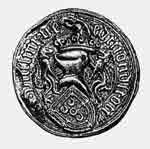
Seal of Sir William Edmonstone of Duntreath, A.D. 1470.
The Acts of the Scottish Parliament prove that in 1464 he was amongst those who took control of the government during the turbulent years of the minority of James III. In May 1469 he became Justice-General for a period of at least eighteen months, and in 1471 and again in 1478 he acted "pro Baronibus' as one of the "Lords of the Articles," the standing committee which used to prepare measures for the Scottish Parliaments.
Thanks to his position of influence Sir William seems to have been instrumental in restoring the lands of the Lennox, the Celtic earldom comprising Dumbartonshire, a large part of Stirlingshire, and parts of Perthshire and Renfrewshire. John Earl of Lennox, by a renunciation and grant, dated Edinburgh August 2nd 1472, gave the Superiority of Duntreath etc to Sir William Edmonstone, allowing him to hold the said lands immediately of the King and confirming the charter of James II of 1452, "in respect of the great kindness, labour and expense of the said William, in recovering the Earl's part of the Earldom of Lennox." An instrument exempting the Barony of Duntreath from the jurisdiction of the Earl of Lennox's courts is dated the 5th August 1472.
A charter of confirmation by King James III, of January 30th 1480 proves that Sir William bought the lands of Cambus Wallace, near Doune, an estate later bequeathed to a cadet member of the family.
During Sir William's lifetime his eldest son Archibald seems to have held a post at court. The Treasurer's account book, in 1477, lists the following. "Given to Archibald of Edmonstowne, 12th of September, to buy a pair of spurs to the King, 4s. From Thome of Yare, and deliueret to Archibald of Edmonstone, 17 Decembris, 2 elnes and ane half for vallous for a porte mantell to the King, price eboue, 45s,. sum £5,12s.6d."
…….
Sir Archibald, 3rd of Duntreath, succeeded his father in 1487. On the 1st June 1488 an instrument of sasine in the lands of Duntreath, as also of coroner to the western portion of Stirlingshire by a precept of James III, was granted to "Archibald, son and heir of William unquhile William of Duntreath." He was also appointed for the districts of Monteith and Strathgartney "anent the stanching of thift reif and enormities, proof that lawlessness was rife."
In 1488 his brother James was appointed to the Parliament held by the Lords, who had put James IV on the throne, to take charge of the peace of the County of Stirling.
Sir Archibald married Janet, daughter of Sir James Shaw of Sauchie in Stirlingshire, formerly Comptroller of Scotland to James III. James Shaw, when Governor of Stirling Castle, was bribed by the King's enemies to refuse him entrance to the castle before the disastrous battle of Sauchie in which he was killed. There is however no indication whatever that Sir Archibald was involved in this treachery.
…….
His eldest son William, 4th of Duntreath, who succeeded him in 1502, was appointed Steward of Monteith and captain of the Castle of Doune in Perthshire. His seal of arms was emblazoned with supporters and crest as of now.
Sir William had four wives. His first Sibylla was the daughter of Sir William Baillie of Lamington. A charter of 1497 granted to William,...of Duntreath, and Sibylla Baillie, his wife, of the lands of Gartbarron, while another of 1506 gave them Argety and Rednock. The cadet families of Cambus Wallace and Newton both descend from James, the 3rd son of this marriage.
Sir William's fourth wife, another Sibylla, was the daughter of Sir John Carmichael of that Ilk, as is shown by a charter under the Great Seal, of the lands of Glenboig and Cambuswallace, to Sir William Edmonstone and Sibylla Carmichael, his wife, on his own resignation.
This was dated August 15th 1513, when already James IV was preparing to lead his army into England. On the 9th September Sir William, together with his brothers-in-law, the Earl of Montrose and Lord Ross, were amongst the "Flowers of the Forest" who fell beside the King in his glorious but fatal stand on the field of Flodden.
Sir William's brother James, Comptroller of Scotland under James IV, apparently survived the battle.
…….
Sir William left five sons and four daughters. He divided his lands amongst his sons. The eldest William succeeded to Duntreath. The second Archibald, to the lands of Rednock (charter dated 1553). The third Robert, to the lands of Cambusbeg in Monteith. The fourth James, to the lands of Westerrowis (charter dated 1540). He also had a natural son named James, as is proved by a charter of legitimisation, who received the lands of Newton of Doune. The cadet branches descended from the four last named are now believed to be extinct.
An instrument of sasine of the Barony of Duntreath to Sir William Edmonstone, 5th of Duntreath, as heir to his father, is dated May 2nd, 1516. In the same year he and his brother, Archibald of Rednock, were appointed to succeed their father as joint keepers of Doune Castle and Stewards of Monteith and Strathgartney.
This was part of the jointure of the queens of Scotland. It was settled upon Queen Margaret, daughter of Henry VII of England, on her marriage with James IV in 1503 and was probably then given into the charge of Sir William who witnessed the sasine. In 1516, three years after his father's death at Flodden, William Edmonstone his heir, by then of age, and his brother Archibald, inherited this charge. But in 1527 the Queen married Henry Stewart, who became Lord Methven (ancestor of the Earls of Moray) and she then petitioned the Council to make over Doune Castle to her husband. Her son, James V, despite a signed agreement with Sir Sir William, did as his mother wished. But Lord Methven then gave Doune Castle to his brother, Sir James Stewart of Beath.
James V died in December 1542 and his widow Mary of Lorraine, then became entitled to the dower lands which included the castle of Doune. Sir William Edmonstone, it seems, was again appointed custodian for among the family papers is a discharge with the sign-manual of the Queen Dowager Mary of Lorraine, to Sir William Edmonstone of Duntreath, Chamberlain Depute of Monteith for the rents of the years 1542-1545, discharging William Earl of Montrose, and all others concerned. It is dated Edinburgh, April 25th, 1549.
Obviously the Stewarts resisted, to what point we do not know, and says the historian Crauford, "it brought the feud to a point. The resentment of the Edmonstones of the House of Duntreath... broke into an open flame. The Laird of Duntreath himself, Archibald and James (of Newton), his brothers, their friends and retainers, happened to encounter Sir James Stewart in the High Street of Dunblane, upon which a sharp and brisk scuffle ensued, in which much blood was shed, and many slain on both sides. The Stewarts' party were worsted, and he himself slain on the spot. This incident fell out on Whitsunday 1543, for which this gentleman, the Laird of Duntreath, found means three years thereafter to procure a remission from the Duke of Chatelherault, Earl of Arran, the Governor, under the Great Seal."
The feud between the Edmonstones and the Stewarts continued for thirty years, until eventually it was settled when Sir William Edmonstone agreed to a bond of manrent (a pledge of support in all quarrels) with the son of Sir James Stewart.
Sir William married firstly, in 1522, the Lady Agnes Stewart, youngest daughter of Matthew, second Earl of Lennox of the Stewart line. Her dower appears to have been "the ten pound land of old extent of Balloch on the Leven, the ancient seat of the older Earls of Lennox.
Subsequent dealings in regard to this land are difficult to interpret. In 1566 a reversion was made by William Edmonstone to Matthew, Earl of Lennox, "of the lands of Balloch, with Millpair of Contenant, the sum of 1000 merks".
Despite this however, some land round Balloch, at the south end of Loch Lomond, must have been retained, or else regained by the Edmonstones. In 1579, Robert, sixth Earl of Lennox exchanged his earldom for the lordship of Dunbar and the earldom of March in an agreement with James VI, who wanted to create the dukedom of Lennox for his cousin and favourite Esme Stewart. A charter of renunciation was then issued, dated August 1579, of the reversion of the lands of Balloch by the said Earl (Lennox) to James Edmonstone of Duntreath, Sir William's son. Furthermore, in 1583 a charter was granted by James VI in favour of Sir James, "renouncing the nonentry of Balloch in consideration of the services of his forbears to the King's ancestors of the house of Lennox".
Further evidence being so far unobtainable it is therefore possible to assume that the land given in security by Sir James Edmonstone, when he later mortgaged Duntreath, included that of Balloch and that it was part of the property never afterwards redeemed.
Reverting now to Sir William. In 1565, when his wife's grandnephew, Lord Darnley married Mary Queen of Scots, William became one of the Lords of the Privy Council and was probably knighted. He was one of the Commissioners to the General Assembly in 1567.
By his first marriage he had a son Archibald, apparently feeble minded, who predeceased him. In 1566 a deed for his suitable maintenance was signed by Queen Mary and her husband Darnley, just before he was murdered.
Sir William married secondly Margaret, daughter of Sir James Campbell of Lawers (ancestor of the Earls of Loudon) and a charter of 1545 records the lands of Cambuswallace as her dower. By her he had James, his heir, and also six daughters. He died a very old man in 1580.
…….
Sir James Edmonstone, 6th of Duntreath, in 1578, (before the death of his father) obtained from Colin 6th Earl of Argyll, Justice-General of Scotland, the grant of a deputation for holding justiciary courts at the fortalice of Duntreath, upon the criminals therein named. Then in 1584 he received the " escheat. of Mungo Edmonstone, the brother of James of Newton, fallen through his treasonable assistance at the late surprizal of the Castle of Sterling."
Stirling Castle had been seized by adherents of the 1st Earl of Gowrie who, following the notorious "Ruthven Raid" of 1582, had held ascendancy over James VI for almost a year. Gowrie, taken prisoner, was brought before "Mr James Graham sitting as Justice," and assisted by men who included "James Edmonstone of Duntreath. The indictment was found relevant, and the Earl, found guilty by his peers, was executed."
In the same year of 1584 Sir James, to his great discredit, acted as an "agent provacateur" in dealings involving friends. On the Earl of Gowrie's arrest his chief supporters, who included the Earls of Angus and Mar, fled to England. The King greatly fearing their influence, and knowing that there was strong feeling against his favourites, the young Duke of Lennox and James Stewart Earl of Arran, proclaimed that anyone informing upon agitators would receive not only a pardon but also a special reward.
Later evidence suggests that Sir James was by then in debt. On his own admission he declared that he "had been led to make a confession of a threefold conspiracy of the exiled Lords against the King, of which he had been informed by Black John Hume of the Law, who came twice to him, each time with a letter of credit of the Earl of Mar, the knowledge of which now preyed on his conscience."
But through family connections he was, in the words of a contemporary, "the Duke of Lennox's man". Thanks to his influence he had been knighted, and as was all important, still held his land from the King.
Therefore when two of his neighbours were suspected of treasonable conspiracy Sir James was persuaded (he said afterwards that Arran threatened and suborned him) to agree to be charged with the same crime of which, upon his confession, he was promised he would be absolved.
The men in question, Malcolm Douglas of Mains and John Cunningham of Drumwhassill, were both of good character, Mains in particular being respected for his valour and his manhood. Nonetheless Robert Hamilton of Eglismachen betrayed them, saying that they had conspired to kidnap the King out hunting "and detain him in some stronghold till the Lords might come and receive him."
Mains and Drumwhassill were arrested and, together with Duntreath, were presented before the Justice, Mr John Graham, on the 9th February 1585. Duntreath was the first to be accused of plotting to kidnap the King. Then Drumwhassill charged with the same crime, was said to have consulted with him thereupon in the churches of Strathblane and Killearn. Mains denied all involvement but all three were convicted and declared guilty of treason. Drumwhassil and Mains, condemned to death, were hanged on the same day in the public street of Edinburgh, but Sir James Edmonstone, significantly, was pardoned.
However he may have benefited from his double dealing, he must for some time afterwards, have lived in constant fear. Hamilton, the informer took refuge in Stirling Castle until, on the fall of Arran from power, he made a desperate effort to escape. But, as he ran, James Johnston of Westraw, "pretending a vow he had made to avenge Main's death, did kill him as he was flying through the park on the south side of the town".
Sir James however survived. He and his son were later accused of involvement with Mr Walter Balcanquall, an extreme Presbyterian agitator believed to be causing sedition, but the case referred to a jury, seems to have been dismissed.
Consequently Sir James continued to be involved in public life. In 1600 he was Chancellor of an Assize.
Then in 1601 he seems to have quarrelled with the Cunninghams, a family into which his daughter had married, for William Cunningham of Tourlands was "condemned to be beheaded for holding his house of Cunninghamhead against the Lairds of Duntreath and Urchill (Graham of Orchil), His Majesty's Commissioners, who were assieging the place for thirteen days, and discharging hackbuts."
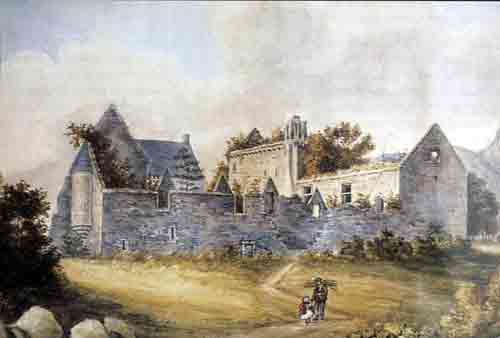
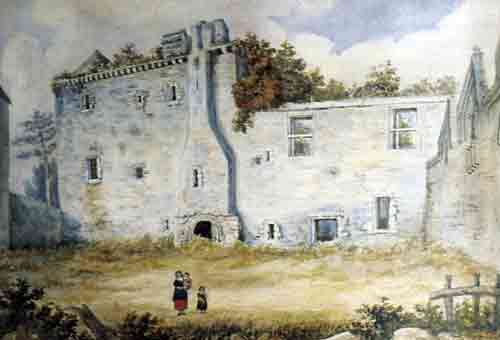
Watercolours of Duntreath as a ruin done by Sir Archibald Edmonstone, 5th Bt.
In 1610, as one of the barons, he was a member of the General Assembly, and in 1614 he sat on the jury at the trial of John Ogilvy a Jesuit, who was hanged.
Sir James is known to have made significant additions to Duntreath. According to the R.C.A.H.M.S. (Vol 1, p 260) "It is highly probable... that Sir James Edmonstone, who not withstanding a somewhat chequered career was a man of considerable status, was in fact responsible for the erection of all the courtyard buildings." The gatehouse, which stood on the west side of the quadrangle, is definitely attributed to him. When rebuilt by Sir Archibald Edmonstone, the 3rd Baronet, in 1863, a stone panel depicting a crest of a camel (the original insignia of the Edmonstones of Duntreath) and the letters S.J. E. K. (Sir James Edmonstone Knight) was found. It still remains at Duntreath.
He may also have built the outer gatehouse, the two being aligned. This,also rebuilt by Sir Archibald, the 3rd Bt., C 1860, now houses the family chapel.
The south east block of the castle, consisted of a two-storied range of buildings with pointed dormers. It was divided into three separate apartments, each with an outside door. The kitchen, on the ground floor, at the south end of the block, contained an enormous fireplace, measuring 14 feet six inches high by 6 feet 8 inches wide. The rooms on the top floor were lit by pedimented dormer windows, as is shown in the water-colour sketches done by Sir Archibald, the 5th Bt.
On the S side (at right angles to the kitchen range) a tower enclosing a staircase gave entrance to the rooms above the kitchen. From the first floor a turret stair led up to a room at the top of the tower where, according to tradition, almost a century later lived William the "Dumb Laird".
The bay window on the main staircase of the Victorian wing, occupied today, probably projects from a remaining part of the original stair-tower.
Plans for further extensions on the south side of the courtyard were abandoned when, in 1609, Sir James and his eldest son made the momentous decision, to move the family to Northern Ireland.
Sir James married firstly Helen, daughter of Sir James Stirling of Keir, by whom he had a son and three daughters, and secondly Margaret, daughter of Sir John Colquhoun of Luss, by whom he a son called Robert and four daughters. According to Sir Archibald, 3rd Bt., Robert died unmarried, but the Genealogy of the Lairds of Ednam and Duntreath (Pub. Glasgow 1699) states that he "went overseas and never return'd again". Therefore it is possible that the American branch of the family descends from him, although it is more likely that James's grandson, another Robert, was in fact the founder of that line. Sir James died C.1618.